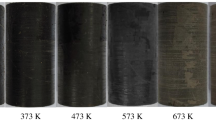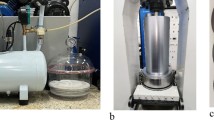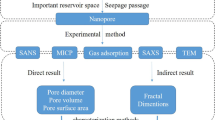Abstract
In this paper, fractal dimension analysis was used to describe pore structure. We proposed a shale water vapor multi-layer adsorption model that considers the control of pore structures. In this respect, the change curve of the water vapor adsorption capacity was found to be consistent with a type II curve. In addition, water vapor adsorption in shale occurs at primary and secondary adsorption sites. When the relative pressure was low, water vapor adsorption in shale occurs at primary adsorption sites. Thus, primary adsorption capacity is greater than secondary adsorption capacity, and changes in the primary adsorption capacity conformed to the characteristics of a type I curve. However, with increasing relative pressure, secondary adsorption sites began to be occupied. The adsorption capacity curves of the two types of adsorption sites intersected. In addition, temperature changes altered the pore structures, and the pore structure had a controlling effect on the adsorption capacity of shale. Temperature was also found to be one of the important factors affecting shale adsorption. Then, we introduced a shale water vapor multi-layer adsorption model that considers both pore structure and temperature. With increasing relative pressure, the water vapor adsorption capacity of shale still maintained the characteristics of a type II curve. However, temperature had an inhibitory effect on the adsorption characteristics in shale. Based on analysis of the changes in shale adsorption at different temperatures, the sorption-induced deformation mechanism caused by water vapor adsorption in shale was further analyzed.












Similar content being viewed by others
References
Bangham, D. H. (1937). The Gibbs adsorption equation and adsorption on solid. Transactions of the Faraday Society, 3, 805.
Boyer, C., Kieschnick, J., Suarez-Rivera, R., et al. (2006). Producing gas from its source. Oilfield Review., 18(3), 36–49.
Brunauer, S., Emmett, P. H., & Teller, E. (1938). Adsorption of gases in multimolecular layers. Journal of the American Chemical Society, 60(2), 309–319.
Chen, X., Yao, G., Herrerobervera, E., Cai, J., Zhou, K., Luo, C., & Lu, J. (2018). A new model of pore structure typing based on fractal geometry. Marine and Petroleum Geology, 18, 291–305.
Cai, J., & Hu, X. (2019). Petrophysical Characterization and Fluids Transport in Unconventional Reservoirs. Elsevier.
Chen, D., Pan, Z., Liu, J., & Connell, L. D. (2012). Modeling and simulation of moisture effect on gas storage and transport in coal seams. Energy & Fuels, 26(3), 1695–1706.
Chen, L., Jiang, Z., Liu, K., Tan, J., Gao, F., & Wang, P. (2017). Pore structure characterization for organic-rich Lower Silurian shale in the Upper Yangtze Platform, South China: A possible mechanism for pore development. Journal of Natural Gas Science and Engineering, 46, 1–15.
Chalmers, G. R., & Bustin, R. M. (2007). The organic matter distribution and methane capacity of the Lower Cretaceous strata of Northeastern British Columbia Canada. International Journal of Coal Geology, 70(1), 223–239.
Cochran, T. W., Danner, R. P., & Kabel, R. L. (1985). Vacancy solution theory of adsorption using flory-huggins activity coefficient equations. AIChE Journal, 31(2), 268–277.
Dent, R. (1977). A multilayer theory for gas sorption: Part I: Sorption of a single gas. Textile Research Journal, 47, 145–152.
Do, D. D. (1998). Adsorption analysis: Equilibria and kinetics (Vol. 2). Imperial College Press.
Dubinin, M. M., & Astakhov, V. A. (1971). Development of the concepts of volume filling of micropores in the adsorption of gases and vapors by microporous adsorbents. Russian Chemical Bulletin, 20(1), 3–7.
Estrada, J. M., & Bhamidimarri, R. (2016). A review of the issues and treatment options for waste water from shale gas extraction by hydraulic fracturing. Fuel, 182, 292–303.
Feng, G., Zhu, Y., Chen, S., Wang, Y., Ju, W., Hu, Y., & Wang, G. (2020). Supercritical methane adsorption on shale over wide pressure and temperature ranges: Implications for gas-in-place estimation. Energy & Fuels, 34(3), 3121–3134.
Fianu, J. S., Gholinezhad, J., & Hassan, M. (2018). Comparison of temperature-dependent gas adsorption models and their application to shale gas reservoirs. Energy & Fuels, 32(4), 4763–4771.
Freundlich, H. (1932). Of the adsorption of gases. Section II. Kinetics and energetics of gas adsorption. Introductory paper to section II, Trans Fara Soc., 28, 195–201.
Frenkel, Y. I. (1955). Kinetic theory of liquids. Oxford University Press.
Gasparik, M., Ghanizadeh, A., Bertier, P., Gensterblum, Y., Bouw, S., & Krooss, B. M. (2012). High-pressure methane sorption isotherms of black shales from the netherlands. Energy & Fuels, 26(8), 4995–5004.
Ghanbari, E., & Dehghanpour, H. (2016). The fate of fracturing water: a field and simulation study. Fuel, 163, 282–294.
Guggenheim, E. A. (1966). Application of Statistical Mechanics. Clarendon Press.
Halsey, G. (1948). Physical adsorption on non- uniform surfaces. The Journal of Chemical Physics., 16, 931–937.
Hill, T. L. (1949). Advances in catalysis. The Journal of Chemical Physics, 17, 580–668.
Hol, S., & Spiers, C. J. (2012). Competition between adsorption-induced swelling and elastic compression of coal at CO2 pressures up to 100 MPa. Journal of the Mechanics and Physics of Solids, 60(11), 1862–1882.
Hu, S., Sun, X. J., Xiang, M., Li, P., & Zhang, L. (2004). Correlation characteristics and simulations of the fractal structure of coal char. Communications in Nonlinear Science and Numerical Simulation, 9(3), 291–303.
Hu, X., Wu, K., Song, X., Yu, W., Tang, J., Li, G., & Shen, Z. (2018). A new model for simulating particle transport in a low-viscosity fluid for fluid-driven fracturing. AIChE Journal, 64, 3542–3552.
Ji, W., Song, Y., Jiang, Z., Chen, L., Li, Z., Yang, X., & Meng, M. (2015). Estimation of marine shale methane adsorption capacity based on experimental investigations of Lower Silurian Longmaxi formation in the Upper Yangtze Platform, south China. Marine and Petroleum Geology, 68, 94–106.
Jiang, F., Chen, D., Chen, J., Li, Q., Liu, Y., Shao, X., & Dai, J. (2016). Fractal analysis of shale pore structure of continental gas shale reservoir in the Ordos Basin NW China. Energy & Fuels, 30(6), 4676–4689.
Keshavarz, A., Badalyan, A., Johnson, R., & Bedrikovetsky, P. (2016). Productivity enhancement by stimulation of natural fractures around a hydraulic fracture using micro-sized proppant placement. Journal of Natural Gas Science and Engineering, 33, 1010–1024.
Ke, H. U., & Mischo, H. (2020). High-pressure methane adsorption and desorption in shales from the Sichuan Basin, southwestern China. Energy & Fuels, 34(3), 2945–2957.
Kumar S., Prasad M., & Pini R. (2015). Selective adsorptives to study pore structure and wetting behavior of self-resourcing shales. In: SPWLA 56th annual logging symposium. Society of Petrophysicists and Well-log Analysts; August.
Li, J., Chen, Z., Wu, K., Wang, K., Luo, J., Feng, D., & Li, X. (2018). A multi-site model to determine supercritical methane adsorption in energetically heterogeneous shales. Chemical Engineering Journal, 349, 438–455.
Liu, X., & Nie, B. (2016). Fractal characteristics of coal samples utilizing image analysis and gas adsorption. Fuel, 182, 314–322.
Li, J., Li, X., Wang, X., Li, Y., Wu, K., Shi, J., & Yu, P. (2016a). Water distribution characteristic and effect on methane adsorption capacity in shale clay. International Journal of Coal Geology, 159, 135–154.
Li, J., Li, X., Wu, K., Wang, X., Shi, J., Yang, L., & Feng, D. (2016b). water sorption and distribution characteristics in clay and shale: effect of surface force. Energy & Fuels, 30(11), 8863–8874.
Li, J., Li, X., Wu, K., Feng, D., Zhang, T., & Zhang, Y. (2017). Thickness and stability of water film confined inside nanoslits and nanocapillaries of shale and clay. International Journal of Coal Geology, 179, 253–268.
Langmuir, I. (1918). The adsorption of gases on plane surfaces of glass, mica and platinum. Journal of the American Chemical Society, 40(9), 1361–1403.
Liang, L., Xiong, J., Liu, X., & Luo, D. (2016). An investigation into the thermodynamic characteristics of methane adsorption on different clay minerals. Journal of Natural Gas Science and Engineering., 33(33), 1046–1055.
Liu, S., & Harpalani, S. (2013). A new theoretical approach to model sorption-induced coal shrinkage or swelling. AAPG Bulletin, 97(7), 1033–1049.
Liu, K., Ostadhassan, M., Gentzis, T., & Fowler, H. (2019). Image analysis of the pore structures: An intensive study for Middle Bakken. Journal of Natural Gas Science and Engineering, 61, 32–45.
Makhanov, K., Habibi, A., Dehghanpour, H., & Kuru, E. (2014). Liquid uptake of gas shales: A workflow to estimate water loss during shut-in periods after fracturing operations. Journal of Unconventional Oil Gas and Resources, 7, 22–32.
Malek, A., & Farooq, S. (1996). Comparison of isotherm models for hydrocarbon adsorption on activated carbon. AIChE Journal, 42(11), 3191–3201.
Nakagawa, T., Komaki, I., Sakawa, M., & Nishikawa, K. (2000). Small angle X-ray scattering study on change of fractal property of Witbank coal with heat treatment. Fuel, 79(11), 1341–1346.
Ren, W., Guo, J., Zeng, F., & Wang, T. (2019). Modeling of high-pressure methane adsorption on wet shales. Energy & Fuels, 33(8), 7043–7051.
Sang, G., Liu, S., & Elsworth, D. (2019). Water vapor sorption properties of illinois shales under dynamic water vapor conditions: experimentation and modeling. Water Resources Research, 55(8), 7212–7228.
Shen, W., Li, X., Lu, X., Guo, W., Zhou, S., & Wan, Y. (2018). Experimental study and isotherm models of water vapor adsorption in shale rocks. Journal of Natural Gas Science and Engineering., 52, 484–491.
Song, X., Lu, X., Shen, Y., Guo, S., & Guan, Y. (2018). A modified supercritical Dubinin-Radushkevich model for the accurate estimation of high pressure methane adsorption on shales. International Journal of Coal Geology, 193, 1–15.
Sun, Z., Li, X., Shi, J., Zhang, T., & Sun, F. (2017). Apparent permeability model for real gas transport through shale gas reservoirs considering water distribution characteristic. International Journal of Heat and Mass Transfer, 115, 1008–1019.
Tan, Y., Pan, Z., Feng, X., Zhang, D., Connell, L. D., & Li, S. (2019). Laboratory characterisation of fracture compressibility for coal and shale gas reservoir rocks: A review. International Journal of Coal Geology, 204, 1–17.
Tan, Y., Pan, Z., Liu, J., Wu, Y., Haque, A., & Connell, L. D. (2017). Experimental study of permeability and its anisotropy for shale fracture supported with proppant. Journal of Natural Gas Science and Engineering, 44, 250–264.
Tang, X., Ripepi, N., Valentine, K. A., Keles, C., Long, T. E., & Gonciaruk, A. (2017). Water vapor sorption on Marcellus shale: measurement, modeling and thermodynamic analysis. Fuel, 209, 606–614.
Teng, T., Wang, J., Gao, F., Ju, Y., & Jiang, C. (2016). A thermally sensitive permeability model for coal-gas interactions including thermal fracturing and volatilization. Journal of Natural Gas Science and Engineering, 32, 319–333.
Tien, C. (1994). Adsorption Calculations and Modeling. Butterworth-Heinemann.
Tokunaga, T. K., Shen, W., Wan, J., Kim, Y., Cihan, A., Zhang, Y., & Finsterle, S. (2017). Water saturation relations and their diffusion-limited equilibration in gas shale: Implications for gas flow in unconventional reservoirs. Water Resources Research, 53(11), 9757–9770.
Wang, Q., & Li, R. (2017). Research status of shale gas: A review. Renew & Sustain Energy Reviews, 74, 715–720.
Wang, J., Hu, B., Liu, H., Han, Y., & Liu, J. (2018a). Effects of ‘soft-hard’ compaction and multiscale flow on the shale gas production from a multistage hydraulic fractured horizontal well. Journal of Petroleum Science and Engineering, 170, 873–887.
Wang, T., Tian, S., Li, G., Sheng, M., Ren, W., Liu, Q., & Zhang, P. (2019). Experimental study of water vapor adsorption behaviors on shale. Fuel, 248, 168–177.
Wang, Y., Zhu, Y., Liu, S., & Zhang, R. (2016). Methane adsorption measurements and modeling for organic-rich marine shale samples. Fuel, 172, 301–309.
Wang, X., Hou, J., Song, S., Wang, D., Gong, L., Ma, K., & Yan, L. (2018b). Combining pressure-controlled porosimetry and rate-controlled porosimetry to investigate the fractal characteristics of full-range pores in tight oil reservoirs. Journal of Petroleum Science and Engineering, 18, 353–361.
Wang, Z., & Tang, X. (2018). New insights from supercritical methane adsorption in coal: Gas resource estimation, thermodynamics, and engineering application. Energy & Fuels, 32(4), 5001–5009.
Yang, R., Aoqi, J., He, S., Hu, Q., Sun, M., Dong, T., et al. (2020a). Experimental investigation of water vapor adsorption isotherm on gas-producing Longmaxi shale: Mathematical modelling and implication for water distribution in shale reservoirs. Chem: Eng. J. https://doi.org/10.1016/j.cej.2020.125982.
Yao, Y., Liu, D., Tang, D., Tang, S., & Huang, W. (2008). Fractal characterization of adsorption-pores of coals from North China: an investigation on CH4 adsorption capacity of coals. International Journal of Coal Geology., 73(1), 27–42.
Yang, R., Jia, A., Hu, Q., Guo, X., & Sun, M. (2020b). Particle size effect on water vapor sorption measurement of organic shale: One example from Dongyuemiao Member of Lower Jurassic Ziliujing Formation in Jiannan Area of China. Advances in Geo-Energy Research, 4(2), 207–218.
Ye, Z., Chen, D., Pan, Z., Zhang, G., Xia, Y., & Ding, X. (2016). An improved Langmuir model for evaluating methane adsorption capacity in shale under various pressures and temperatures. Journal of Natural Gas Science and Engineering, 31, 658–680.
Zhang, L., Li, J., Tang, H., & Guo, J. (2014). Fractal pore structure model and multilayer fractal adsorption in shale. Fractals, 22(03), 1440010.
Zhang, T., Li, X., Wang, X., Li, J., Sun, Z., Feng, D., et al. (2018). A discrete model for apparent gas permeability in nanoporous shale coupling initial water distribution. Journal of Natural Gas Science and Engineering, 59, 80–96.
Zolfaghari, A., Dehghanpour, H., & Holyk, J. (2017). Water sorption behaviour of gas shales: I. Role of clays. International Journal of Coal Geology, 179, 130–138.
Zhou, Y., Li, Z., Yang, Y., Zhang, L., Qi, Q., Si, L., & Li, J. (2016). Improved porosity and permeability models with coal matrix block deformation effect. Rock Mechanics and Rock Engineering, 49(9), 3687–3697.
Zhou, J., Liu, M., Xian, X., Jiang, Y., Liu, Q., & Wang, X. (2019a). Measurements and modelling of CH4 and CO2 adsorption behaviors on shales: Implication for CO2 enhanced shale gas recovery. Fuel, 251, 293–306.
Zhou, S., Zhang, D., Wang, H., & Li, X. (2019b). A modified BET equation to investigate supercritical methane adsorption mechanisms in shale. Marine and Petroleum Geology., 105, 284–292.
Zou, J., Rezaee, R., Xie, Q., & You, L. (2019). Characterization of the combined effect of high temperature and moisture on methane adsorption in shale gas reservoirs. Journal of Petroleum Science and Engineering, 182, 106353.
Acknowledgement
This study was financially supported by the National Natural Science Foundation of China (Grant Nos. 52064007, 51804085, and 51911530203).
Author information
Authors and Affiliations
Corresponding author
Rights and permissions
About this article
Cite this article
Li, J., Li, B. & Gao, Z. Water Vapor Adsorption Behavior in Shale Under Different Temperatures and Pore Structures. Nat Resour Res 30, 2789–2805 (2021). https://doi.org/10.1007/s11053-021-09846-0
Received:
Accepted:
Published:
Issue Date:
DOI: https://doi.org/10.1007/s11053-021-09846-0




